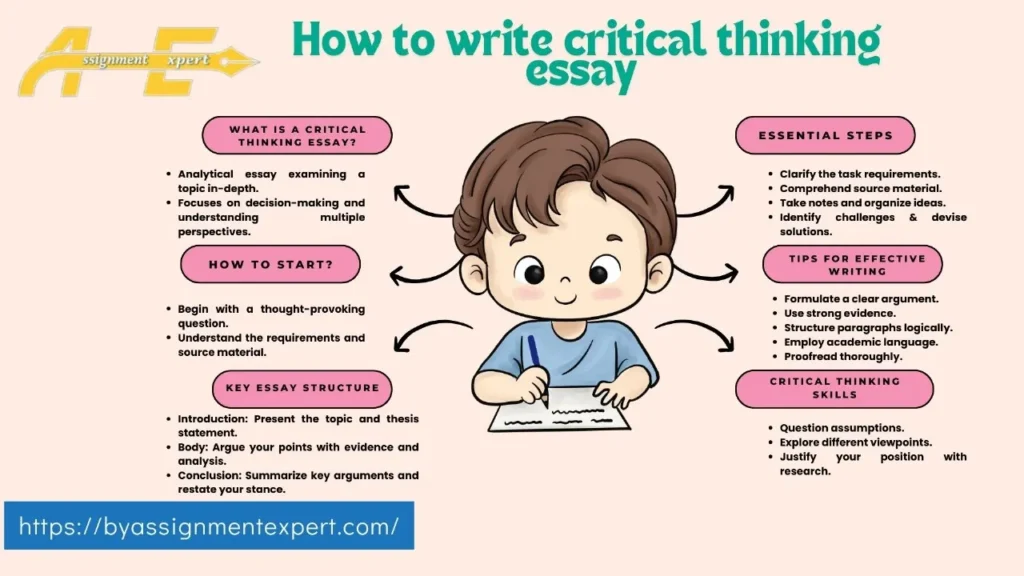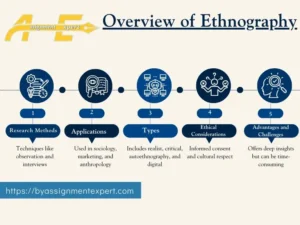Critical thinking is all about logical thought processes which is based on perfect evaluation and organizing our thoughts. It is based on our involvement, perception and bits of knowledge, almost the possible consequences. Critical thinking authorizes students to get objective results and express their thoughts efficiently. It also assists in stopping analytical misunderstandings and unreliable disagreements.
Critical essay writing is a sort of essay writing which includes translating, analyzing and assessing the information or a piece of work. This type of writing demands the writer to go beyond the summary and engage deeply into the content. This blog will guide you to get perfect university or college essay about critical thinking.
What Makes a Critical Thinking Essay?
A critical thinking essay analyzes an issue and looks at it through a comprehensive set of actions and then chooses a course of action to evaluate it.
Unlike traditional essays, it begins with a question rather than a definitive thesis, allowing you to gain a deeper understanding of a specific issue. The fundamental purpose of critical writing is to enhance your analytical abilities and promote interesting thought.
How to Start a Critical Thinking Essay?
Starting a basic critical thinking essay requires more than basically making an introduction. Start by asking a related and thought-provoking question. This method will coordinate and shape the establishment of your analysis. Make sure you understand the requirements and source material for the essay, which will nature your perspective and argument.
Structure of Critical Thinking Essay Writing
Structuring critical essay is crucial for creating a compelling writing.
Introduction
In the presentation, give a brief introduction and express your point simply. To do this effectively, guarantee you thoroughly understand the critical thinking essay topics at hand. Reading resources on avoiding plagiarism can also be beneficial.
Writing a critical thinking essay is more manageable than it might seem; proper planning is key. In your introduction, briefly discuss the topic and present your stance. This area is vital as it attracts the readers, empowering them to proceed reading.
Body
Within the body, present your essential contention and prove it with solid evidence
Much like writing an autobiographical essay or reflective essay writing, your key points should be proved with appropriate evidence. This section is vital because it contains all your main arguments.
Carefully plan this part, presenting your argument clearly and backing it up with evidence. Your central argument should be robust enough to persuade the reader to view the issue from your perspective and comprehend your message clearly.
Conclusion
The conclusion ties together the fundamental focuses of your paper. Here, you should summarize your key arguments, succinctly explaining your viewpoint. In essence, this section should coherently consolidate what you’ve discussed throughout the essay. When you present your final argument, you enable readers to draw a logical conclusion from your discussion, making this part just as important as the rest.
This outline will help you build a stronger essay and optimize your chances of scoring well.
How to Write the Best Critical Essay Introduction
The introduction acts as a guide for students, offering a general overview of the essay’s content. When forming your introduction, envision it as creating a map for the reader; it not only emphasizes the final destination but also explains the journey ahead.
A well-created introduction typically completes four essential functions:
- Describes the reader’s attention.
- Clearly displays the essay’s central argument.
- Provides a general meaning and common overview for the topic.
- Highlights the seriousness of the current challenge.
To simplify the method of writing an effective introduction, consider these strategies:
- Begin with a summary of the essay’s subject matter.
- Clearly state the major proposal or primary thought.
- Characterize basic terms and concepts pertinent to your argument.
- Outline the key issues you plan to explore or argument within the essay.
- Explain the methodology you employed and the rationale behind its selection.
- Incorporate a persuading touch to lock in the readers right from the beginning.
How to Develop a Successful Critical Thinking Essay?
Students often put significant effort into incorporating critical thinking into their essays. It’s a task that showcases their analytical abilities. Although it may seem challenging, you can break it down into simpler steps to make it easier. Follow these proposals to exceed expectations in composing your basic considering exposition:
- Clarify the Requirements
- Comprehend the Source Material
- Take Notes
- Assessing Challenges
- Devise Solutions
Step 1 – Clarify the Requirements
What is assumed of you is to start it by fully comprehending it. You can manage any assignment effectively only when you have a clear understanding of the requirements. For students, breakdown to meet essential standards frequently appears due to a general lack of understanding. If any phase is unclear, do not wait to obtain clarification from your instructor.
Step 2 – Comprehend the Source Material
Your viewpoint is created by the resources you use. Therefore, it’s fundamental to completely understand the material and how to apply it efficiently. Once you achieve this, your composing will actually become comprehensive.
Step 3 – Take Notes
It’s appropriate to scribble down notes as you collect evidence.
While writing your essay, several relevant points may come to mind. Make sure you record them as they occur to avoid missing out on valuable awareness. This practice will make the writing process flow, with ideas flowing more naturally.
Step 4 – Assessing Challenges
When considering around distinctive basic critical thinking essay points, distinguish the primary challenges you anticipate to stand up to. Identifying these challenges will help you choose an appropriate approach, eventually leading to a stronger essay. Recognizing potential barriers is essential for addressing them effectively.
Step 5 – Devise Solutions
Having recognized the challenges in the previous step, the next task is to find viable solutions. A solid grab of the source material will help you in this process. Success centers on clearly understanding your direction and how to cross it.
How to Refine Your Critical Thinking Essay
Now that you are familiar with what constitutes a critical thinking essay and how to write one, here are some additional tips to refine your approach:
- Formulate a Clear Argument
- Effectively Utilize Evidence
- Structure Paragraphs Strategically
- Employ Academic Language
- Proofread Thoroughly
Formulate a Clear Argument
Confirm that your ideas are displayed without uncertainty. The reader should be able to recognize your message with firm clarity, specifically your thesis statement, which must be clearly communicated.
Effectively Utilize Evidence
The proof you provide must be well structured and appropriate. Once you have a clear understanding of your topic, you can show your viewpoint more strongly.
Structure Paragraphs Strategically
When writing paragraphs, do so with purpose. Every paragraph should introduce a new idea, preserving a rational and balanced flow through your essay. This strategy helps in supporting clarity and direction in your composing.
Employ Academic Language
For an academic essay, it is important to use formal language that indicates your depth of understanding. This choosing of dialect is a key sign of your scholarly competence.
Proofread Thoroughly
After completing your essay, take the time to edit it methodically. This stage is primary for identifying and changing errors that may have been ignored during the writing process. Commonly, in the spring of writing, small errors can go ignored, so restoring your work safeguards it meets the highest guidelines.
Pro Tips for Enhancing Your Critical Thinking and Writing Abilities
Critical considering clashes from the programmed nature of regular thought. Not at all like schedule considering, basic considering requires purposefulness and think exertion.

To improve this skill and incorporate it into your regular thought processes, consider the following strategies:
Put Fundamental Questions
Investigation can sometimes become excessively complex. To sustain clarity, constantly return to the fundamentals of your topic.
Challenge Core Assumptions
While examining a problem, examine your introductory beliefs. Reflect the possibility that they may be wrong and keep an open mind during your research.
Cultivate Independent Thought
Oppose the persuasion to be affected by others’ opinions during your research. Maintain your own analytical perspective.
Consider Reversal
What may seem like a basic cause-and-effect relationship might be reversed. Explore the plausibility that the influenced cause may be the impact, and bad habit versa.
Critically Assess Existing Evidence
When working with sources, it’s fundamental to thoroughly assess and question the reliability and relevance of the facts provided.
How to Display Critical Thinking in Your Writing
Critical thinking forces you to grow beyond your current knowledge and discover different viewpoints. To efficiently stage your critical thinking capacities in writing, consider employing the following approaches:
Read Extensively
Some time recently you start composing, inundating yourself in all accessible writing on your chosen subject. Pay close attention to the key aspects relevant to your assignment.
Conduct Thorough Research
Consult multiple scholarly sources and examine deeply into the information they provide. This will facilitate a deep and complete comprehension of the topic.
Evaluate Information Critically
Assess the sources and data you have brought together carefully. Encounter yourself to see if there are any points where you might oppose the authors’ viewpoints.
Justify Your Position
Distinctly communicate whether you agree or disagree with the authors’ conclusions and establish your position with strong proof.
A well-reasoned essay not only allows you to present your arguments efficiently but also ensures that your paper ends in a consistent and reasonable conclusion.
How Do You Write a Critical Thinking Report?
A critical thinking report follows a similar formation to a critical thinking essay but is frequently more detailed in its analysis. It includes not just presenting an argument but also calculating the sources and proving critically. The report should reflect your ability to think independently, question expectations, and draw well-maintained conclusions.
Top Critical Thinking Essay Topics
If you haven’t yet decided on a topic for your essay, feel free to draw a vision from the following examples. You can apply them as titles for your paper or as a beginning point for your own ideas. Select a subject that honestly appeals you:
- Discovering Health Differences: Racism and Inequality in Medical Treatment
- Body Image and Self-Acceptance: Psychological and Social Implications
- Critical Thinking vs. Creative Thinking: Analyzing Their Relationship
- Emerson’s Spiritual Vision: Nature and Religion in 19th-Century American Poetry
- The Role of Digital Innovation in Shaping Human Interaction
- Exploring Social Media’s Influence on Teen Identity Formation
- Children in Media: Evaluating the Accuracy and Impact of Their Representation
- Long-Term Results of Household Viciousness on Victims
- The Impact of Community Support Systems on Social Well-Being
- Cognitive Effects of Stereotyping: How Labels Shape Perception
- Comparative Views of Happiness: Cultural Variations and Commonalities
- Environmental Art as a Catalyst for Ecological Awareness and Change
- The Psychology of Belonging: Devotion and Its Role in Human Behavior
- Antibiotics and Beyond: How Medicine Has Evolved Over the Decades
- Exploring Solutions for Equity in Professional Sports
- Gun Control Policies: Assessing Their Impact on Public Safety
- The Evolution of Romantic Ideals: Historical and Cultural Perspectives
- Social Media Adoption Among Older Adults: Benefits and Challenges
- Contemporary Art Forms: Evaluating Drawing’s Place in Modern Art
- Health risks associated with extreme sugar consumption.
- The permanent popularity of reality TV shows: An analysis.
- The importance of healthy eating habits.
- An estimation of fairness and effectiveness in the US judicial system.
- The event of Cirque du Soleil: Reasons and analysis.
- Strategies for ending police brutality.
- Freedom of speech: Does it truly exist?
- The influence of vaccination misconceptions on public health.
- Creating an activity arrange to address Unused Brunswick’s statistical challenges.
- The aspects of a good movie: A critical examination.
- A fundamental examination of your favorite book.
- The connection of fashion and identity.
- How taboo topics are approached in Gothic literature.
- Overpopulation: A critical thinking essay on its challenges and solutions.
- The affect of way of life on mental health.
- The part of self-esteem in maintaining a strategic distance from childhood eating clutters
- Teenage drug abuse: Causes and outcomes.
- The influence of violent video games on children’s mental health.
- The effects of stress on team production.
- The significance of natural ponders in cutting edge education.
- Morals and basics in the interest of a cheerful life.
- The role of human worthiness in promoting justice.
- The morals of broadcasting in the tobacco industry.
- Research misconduct: Causes and potential solutions.
- The implications of parental employment on children’s well-being.
- The social result of superheroes in American society.
- The dual effect of technology on modern life: Pros and cons.
- The financial changes activated by the COVID-19 widespread.
- Mandatory vaccination: Benefits and potential drawbacks.
Critical Thinking Essay Example for Students
Analyzing examples of critical thinking essays can provide valued perceptions into how to structure your argument and present your examination. For example, a critical thinking essay on “Morals of broadcasting in the tobacco industry” will require to address all aspects around what, why, where, who and how types questions. By examining well-crafted essays, you can better know how to apply critical thinking skills to several topics, from literature to social issues.
By following these guidelines, you’ll be well-resourced to write an outstanding critical thinking essay. Best of luck!
















